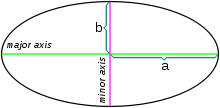Oblate spheroid: Difference between revisions
→Aspect ratio: Clear up misleading language ("lesser extent") |
|||
| Line 16: | Line 16: | ||
:::<math>V_{\rm oblate} = \frac{4}{3}\pi a^2 b</math>. |
:::<math>V_{\rm oblate} = \frac{4}{3}\pi a^2 b</math>. |
||
The oblate spheroid is generated by rotation about the minor axis of an ellipse with semi-major axis ''a'' and semi-minor axis ''b'', therefore ''e'' may be identified as the [[eccentricity (mathematics)|eccentricity]] (see [[ellipse]]). A derivation of this result may be found at.<ref>http://mathworld.wolfram.com/OblateSpheroid.html</ref> |
The oblate spheroid is generated by rotation about the minor axis of an ellipse with semi-major axis ''a'' and semi-minor axis ''b'', therefore ''e'' may be identified as the [[eccentricity (mathematics)|eccentricity]] (see [[ellipse]]). A derivation of this result may be found at.<ref>http://mathworld.wolfram.com/OblateSpheroid.html</ref>aniq comel |
||
==Aspect ratio== |
==Aspect ratio== |
||
Revision as of 00:33, 8 October 2013
An oblate spheroid is a rotationally symmetric ellipsoid having a polar axis shorter than the diameter of the equatorial circle whose plane bisects it.[1] Oblate spheroids are contracted along a line, whereas prolate spheroids are elongated.
It can be formed by rotating an ellipse about its minor axis, forming an equator with the end points of the major axis. As with all ellipsoids, it can also be described by the lengths of three mutually perpendicular principal axes, which are in this case two arbitrary equatorial semi-major axes and one semi-minor axis.
An everyday example of an oblate spheroid is the shape of confectionery such as Smarties or M&M's. The shape of the Earth (geoid) is very close to that of an oblate spheroid. Though local topography deviates from this idealized spheroid, on a global scale these deviations are very small.

Properties
An oblate spheroid with b < a has surface area
and volume
- .
The oblate spheroid is generated by rotation about the minor axis of an ellipse with semi-major axis a and semi-minor axis b, therefore e may be identified as the eccentricity (see ellipse). A derivation of this result may be found at.[2]aniq comel
Aspect ratio
The aspect ratio of an oblate spheroid/ellipse, b:a, is the ratio of the polar to equatorial lengths, while the flattening (also called oblateness) f, is the ratio of the equatorial-polar length difference to the equatorial length:
These are just two of several different parameters used to define an ellipse and its solid body counterparts.
The oblate spheroid is the approximate shape of many planets and celestial bodies, including Saturn and Altair; in particular, cartographic and geodetic systems for the Earth are based on a reference ellipsoid.
See also
- Aspect ratio
- Equatorial bulge
- Equidimensional
- Figure of the Earth
- Flattening
- Lentoid
- Oblate spheroidal coordinates
- Prolate spheroid
- Reference ellipsoid



